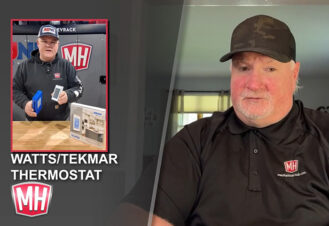Mechanical Hub talks smart pumps with Grundfos, Taco & Xylem
Let’s face it: In an industry that is considered slow to change, some things are moving at a brisk pace toward the future. Take pumps, for example. Over the last decade, technology and innovation has improved by leaps and bounds. So much so, in the water movement industry, you’ll often hear professionals refer to pumps and circulators as “smart” or “intelligent.”
Mechanical Hub’s primary focus is to bring the latest information to you the reader. The Hub recently talked with representatives from Grundfos Pumps, Taco, Inc. and Xylem, respectively, to gauge what is going on in the smart pump market. Mechanical Hub recently talked with Joe Rice, product manager, Grundfos Pumps; Doug Bird, senior product manager, water circulation, Taco; and Chrishelle Rogers, product manager, circulators and accessories, Xylem.
 With an annual production of more than 17 million pumps, Grundfos is a leading pump manufacturer and trendsetter in water technology. The company specializes in circulator pumps for heating and air conditioning, as well as centrifugal pumps for industrial applications, water supply, sewage and dosing. In addition to pumps, Grundfos produces standard and submersible motors, and state-of-the-art electronics for monitoring and controlling pumps.
With an annual production of more than 17 million pumps, Grundfos is a leading pump manufacturer and trendsetter in water technology. The company specializes in circulator pumps for heating and air conditioning, as well as centrifugal pumps for industrial applications, water supply, sewage and dosing. In addition to pumps, Grundfos produces standard and submersible motors, and state-of-the-art electronics for monitoring and controlling pumps.
Founded in 1945 in Bjerringbro, Denmark, the Grundfos Group today achieves $4 billion in annual turnover and employs nearly 20,000 people in more than 55 countries worldwide. The company expanded to North America in 1973, and its regional headquarters is located in Olathe, Kan. Grundfos now employs 1,400 people in the United States. In the past decade, Grundfos has acquired several brands to increase its competencies in North America: ALLDOS, PACO, Peerless Pump and Yeoman’s Chicago Corporation. For more information on Grundfos Pumps, visit www.grundfos.com.
Taco, Inc., headquartered in Cranston, R.I., develops and manufactures hydronic-based components for use in heating and cooling applications across the building spectrum — residential, commercial, industrial and institutional.
Its wide range of hydronic and radiant systems and components include pumps, heat exchangers, expansion tanks, flow measurement devices, air separators and valves, and zone control products. It is also one of the best-known brands in the hydronic industry, long associated with continual product innovation and development.
Taco is proud to be an ISO 9001-registered company, producing products at internationally recognized quality standards. For more information on Taco Pumps, visit www.taco-hvac.com.
Xylem is a leading global water technology provider, enabling customers to transport, treat, test and efficiently use water in public utility, residential and commercial building services, and industrial and agricultural settings. The company does business in more than 150 countries through a number of market-leading product brands, and its people bring broad applications expertise with a strong focus on finding local solutions to the world’s most challenging water and wastewater problems. Launched in 2011 from the spinoff of the water-related businesses of ITT Corporation, Xylem is headquartered in White Plains, N.Y., with 2011 revenues of $3.8 billion and 12,500 employees worldwide.
The name Xylem is derived from classical Greek and is the tissue that transports water in plants, highlighting the engineering efficiency of our water-centric business by linking it with the best water transportation of all — that which occurs in nature. For more information, visit www.xyleminc.com.
Hub: Why are pumps considered “intelligent”?
Rice/Grundfos: Take our MAGANA pump. The MAGNA features AUTOADAPT, a technology unique to Grundfos. It is a proportional pressure control with increased intelligence. AUTOADAPT takes the guesswork out of setting up the pump, enabling it to adjust its own set point based on actual system performance. In AUTOADAPT mode, the MAGNA looks for the highest flow condition existing in the system and adjusts its set point for that condition. This results in the lowest possible set point – and lowest energy consumption – for the pump based on actual system performance. AUTOADAPT removes the unknowns when configuring a system, giving it the best efficiency rate for real-world applications.
 Bird/Taco: Taco’s Viridian wet-rotor pump with an ECM motor offers an 80 percent decrease in energy consumption compared to a standard commercial pump of the same size. With fully automated variable speed operation, simple Web-style controls and capacities up to 375 GPM, the Viridian line meets the widest range of closed-loop heating and cooling applications. An ethernet connection on the pump allows for remote control, monitoring and adjustment without requiring the involvement of advanced IT or commissioning personnel. Any Viridian pump can be instantly accessed via a laptop or standard Internet browser. The Viridian features a working pressure of 175 psi, and is suitable for fluid temperatures from 14°F to 230°F. The VR15 and VR20 can accept 110-240 volts, while the larger VR25 and VR30 operate on 200-240 volts. The cost of ownership of a Viridian pump is by far the lowest for its performance range, and since it’s a Taco, you can be assured it’s also the greenest pump available.
Bird/Taco: Taco’s Viridian wet-rotor pump with an ECM motor offers an 80 percent decrease in energy consumption compared to a standard commercial pump of the same size. With fully automated variable speed operation, simple Web-style controls and capacities up to 375 GPM, the Viridian line meets the widest range of closed-loop heating and cooling applications. An ethernet connection on the pump allows for remote control, monitoring and adjustment without requiring the involvement of advanced IT or commissioning personnel. Any Viridian pump can be instantly accessed via a laptop or standard Internet browser. The Viridian features a working pressure of 175 psi, and is suitable for fluid temperatures from 14°F to 230°F. The VR15 and VR20 can accept 110-240 volts, while the larger VR25 and VR30 operate on 200-240 volts. The cost of ownership of a Viridian pump is by far the lowest for its performance range, and since it’s a Taco, you can be assured it’s also the greenest pump available.
The Viridian offers variable speed capability based on several pre-set parameters: fixed flow, power, constant pressure or proportional pressure — all based on Delta P. The Viridian will vary its speed accordingly and can be monitored and controlled remotely through a web-based portal.
Rogers/Xylem: These pumps are considered “smart pumps” because of the unique software programmed into the pumps. The ecocirc® auto model is able to calculate the flow and then determine the correct speed to operate at maximum capacity with minimum energy consumption.
The ecocirc line has dry-run protection built into the software. This means that the circulator will recognize when there is no water in the pump housing and automatically enters a protection mode until the presence of water is detected.
In addition to dry-dun protection, our circulators are programmed to detect when there is an error and informs the end user.
Hub: How do these circulators “breathe” energy efficiency and water conservation?
Rice/Grundfos: There are more than 150 million circulators pumps in operation throughout North America and Europe today. Most these pumps are inefficient and drain the energy infrastructure. The MAGNA was designed and built from the ground up with efficiency in mind. It reduces energy consumption by up to 85 percent. The impeller is of a high efficiency 3D design to ensure the broadest optimal efficiency across the operating range. The pump and impeller are built to very high tolerances to minimize losses within the pump itself. The motor is an ECM motor with Permanent Magnet rotor, which drastically reduces electrical power consumption compared to traditional Induction motors, which require line power to magnetize the rotor. Additionally, further energy savings come from the intelligence built into the pump — including constant pressure, proportional pressure, and the unique AUTOADAPT control modes. AUTOADAPT enables the pump to learn from the system demands over time and reduce its own setpoint to minimize the energy consumption while meeting the system flow demands.
Bird/Taco: Let’s focus on energy efficiency since hydronic or chilled water systems are closed loop. As for energy efficiency, the Viridian pump is powered by a permanent magnet, ECM motor that operates on very significantly reduced power.
 Rogers/Xylem: The heart and soul of our circulators is the energy-efficient spherical rotor/impeller design. This combined with an Electronically Commutated Motor (ECM) will result in significant energy savings through improved performance.
Rogers/Xylem: The heart and soul of our circulators is the energy-efficient spherical rotor/impeller design. This combined with an Electronically Commutated Motor (ECM) will result in significant energy savings through improved performance.
Our autocirc® line of pumps will help an average family of four save thousands of gallons of water annually.
Hub: These circs definitely help in saving energy in a heating/cooling system overall but, are they more or less energy consumptive in the manufacturing process? What materials are used, are they potentially hazardous in their disposal or manufacturing?
Rice/Grundfos: MAGNAs are manufactured with a “cradle to grave” mentality to ensure minimal impact on the environment. More than 90 percent of the materials used in the MAGNA are recyclable.
Rogers/Xylem: These circulators are made with the same materials found in the current induction motors and with only one moving part, reduce energy consumption. There are no hazardous materials in the manufacturing or disposal process.
Hub: Should we expect the cost to come down in time due to more manufacturers making the product?
Rice/Grundfos: The MAGNA product is valued competitively in the market, often resulting in a payback of less than two years when compared to a traditional circulator. Creating high-value, high-quality products like the MAGNA is a challenge few companies can achieve.
Rogers/Xylem: Yes, the cost will go down as more innovative manufacturing techniques are introduced. As the cost of manufacturing goes down, the circulators will come with more features and have higher standards to compete in this competitive market.
Hub: Are there plans to move to a multi-mode program that is user-defined for mode of operation?
Bird/Taco: Here’s our opportunity to tell you about Taco’s newest ECM-driven BumbleBee circulator – a three-mode, fully-programmable pump that operates in setpoint (fixed temperature), Delta T, or a fixed speed (one of four speeds).
The BumbleBee is a variable speed, wet-rotor circulator. The high-efficiency, ECM motor requires only 9 to 42 watts, depending on the load. The pump can operate in three different modes:
• Delta-T (ΔT) differential temperature mode for fixed settings from 5°F to 50°F difference between supply and return sensors
• Fixed speed for a specific gpm
• Set point mode to meet a desired temperature (65°F to 220°F)
 The Bumblebee features a brushless DC, permanent magnet motor with the option of 115 – 230v, 50/60 Hz input power. The programmable pump offers new plug-in remote temperature sensors and a digital display that reveals real-time watt usage and gpm flow.
The Bumblebee features a brushless DC, permanent magnet motor with the option of 115 – 230v, 50/60 Hz input power. The programmable pump offers new plug-in remote temperature sensors and a digital display that reveals real-time watt usage and gpm flow.
Taco’s BumbleBee Circulator, part number HEC-2, offers a broad performance range, covering flows from 0 to 15 gpm and heads from 0-15 feet, making it an ideal choice for many hydronic, radiant heat and snowmelt applications, whether residential or light commercial.
An integral flow check (IFC) is included in the carton that can be pressed into the discharge flange, if required. The circulator has an improved terminal box for ease of wiring to any Taco Switching Relay or Zone Valve Control. To further ease installation and mounting flexibility the rotating swivel-flanged casing provides 360-degrees of rotation.
Rogers/Xylem: In 2013, Bell & Gossett will be launching a new product line that will have multi-mode settings for the user to specify the mode of operation.
Hub: Any plans of manufacturing “mini” sized circs for use as a single loop (radiant application) circulator? This could take the energy consumption to a new low.
Rice/Grundfos: The MAGNA has multiple user-selected control modes, as well as the ability to connect external control for custom operation. Grundfos continuously challenges the status quo. Expect new, advanced control methods to evolve over time.
Bird/Taco: No. Our current line of variable speed Delta-T circulators (00-VDT) and the new BumbleBee provide large operating ranges to match the needs of single or multiple zone applications.
Rogers/Xylem: The ecocirc SC is Bell & Gossett’s mini-sized circulator that can be used for hydronic zoning. These circulators are tiny in size but still pack a punch. As for energy consumption, these circulators operate on extremely low input power at a specified nominal voltage from 8 to 24 volts.
Hub: Any plans being made to make the circulators “repairable”?
Rice/Grundfos: One of the greatest customer benefits of the MAGNA is that the pump is maintenance-free. Many traditional circulators installed throughout North America require maintenance repair approximately every 18 months. This is quite costly and time consuming for building owners and managers.
Rogers/Xylem: Currently, there is a rotor repair kit available. This repair kit will allow a service repair person to replace the only moving part in the pump, which results in lower repair costs overall.




Join the conversation: